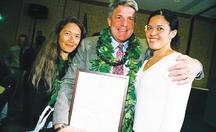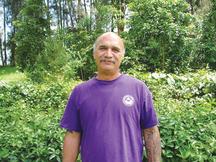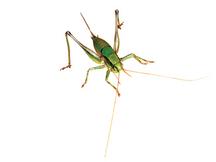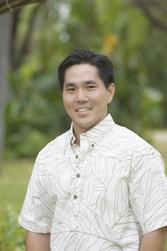April 23, 2009
 |
 |
 |
"Sometimes
our fate resembles a fruit tree in winter. Who would think that those
branches would turn green again and blossom, but we hope it, we know
it."
- Johann Wolfgang von Goethe
Remember
when green was just a color? Ah, those were simpler times. But even
before it morphed into the buzzword of the environmental movement,
green had roots in something deeper.
Etymologists trace
the word back to the Old English groeni, which was closely tied to
growan, meaning "to grow." Some of green's other meanings—like fresh
and new or "go"—also speak to its potential as a powerful, malleable
force greater than the sum of its five letters. A concept. A rallying
cry. An inspiration.
And that's exactly what it's been to the
millions of people who have begun the difficult work of reversing
humanity's long, rapidly accelerating march toward self-destruction.
Faced with obstacles that some call insurmountable, the leaders of the
burgeoning eco revolution have grabbed hold of a simple concept—that we
should all be stewards of this incredible, fragile planet—and molded it
into something profound.
Of course, the work is only beginning
and the challenges are many. But there are signs that the tide has
started to turn, that we are collectively waking up to the fact that
tomorrow is pounding down the door and can no longer be ignored.
The green era has arrived—it's time for all of us to show our true colors.
...
Special Rob Report:
Three islands, three Isaacs
A trio of environmental heroes is fighting to protect Hawaii's resources
By Rob Parsons
Earth
Day, plunked before the backdrop of spring's resiliency and renewal,
affords us an annual opportunity to assess how we're doing at taking
care our planet.
Facing rapid population growth, increasing
urbanization and degradation of precious natural resources, the
Hawaiian Islands are a poster child for environmental efforts, and
failings. The rapid loss of native habitat from the sandalwood industry
in the early 1800s was the first, damaging step in upsetting a balance
that had taken millions of years to develop.
Today, Hawaii
has become one of the world's hotspots for threatened and endangered
native flora and fauna. Conservation and restoration efforts, while
often heroic in scope, are woefully under-funded, considering the
myriad threats to native plants, birds, mammals and marine life.
Fortunately,
there are individuals who have dedicated their lives, and livelihoods,
to furthering Hawaii's environmental causes. Coincidentally, three such
eco-defenders bear the same given name: Isaac. Though all have Maui
roots, the efforts of Isaac Hall, Isaac Moriwake and Isaac Harp now
encompass three major Hawaiian islands, while the ripples of their
efforts spread even farther.
 |
|
 |
Hailing from Oahu, Earthjustice
attorney Isaac Moriwake attended college at Pomona, an area he
describes as "the armpit of Los Angeles." With frequent smog alerts and
other trappings of the urbanized environment, Moriwake says he gained
perspective and appreciation for how good we have it in Hawaii.
He
returned to Oahu to attend law school, a decision he said was his "best
move ever." He found himself fascinated with the rich legal history of
land and water in Hawaii, and became increasingly interested in doing
whatever he could to help protect what makes the islands so special.
After
clerking for the Hawaii Supreme Court and briefly working for a private
firm, the Earthjustice position opened up about six years ago. "I'm now
doing my dream job every day," says Moriwake.
During his
tenure with the national eco-organization, Moriwake has led challenges
to shoreline certification criteria to preserve coastal property and
access, and fought to require an EIS when the Department of Agriculture
wanted to study genetically modified algae at the Kona research site.
He has also contributed to challenges over the Stryker Brigade,
military training in Oahu's Makua Valley and open-air testing of GMO
bio-pharmaceuticals.
But Moriwake is best known for his ongoing
work on Maui water issues, primarily the contested stream restoration
case of Na Wai Eha. "Private companies are ill-suited to manage a
public resource like water because they care only about profit, rather
than the greater good," says Moriwake. "If ever there was an
example of why water must be managed as a public resource, rather than
a private commodity, Maui is it."
Moriwake believes Maui County
must exhibit more leadership in water resource management and in water
conservation. Honolulu, he notes, has avoided any increases in pumping
over the past 10 years by focusing on conservation measures. "The
County should be asserting control of its water future," he says, "for
the benefit of the people."
Moriwake notes that environmental
consciousness is at an all-time high. "Green is in vogue like never
before," he says. "But we've lost too much already and we're going to
have to wake up and get busy. Every case I've been involved in,
including the water case, begins and ends with folks taking
responsibility for protecting our home, what makes Hawaii special."
 Isaac Hall |
 |
 |
Connecticut
native Isaac Hall went to Princeton University and Columbia Law School,
then worked on prisoners' rights in Harlem before moving to Hawaii in
1973. Soon after, he became involved with efforts to protect
Kaho'olawe, then known as the "Target Island" for the decades of
military training exercises that were conducted there, and return the
island to the people of Hawaii. In 1978 he began practicing law. Four
years later, he married Dana Naone, and they embarked on their
partnership working on Native Hawaiian, land, water and environmental
issues.
Together, they worked with Hui Alanui o Makena against
closure of the Makena Road in front of Seibu's Maui Prince Hotel and
protected coastal resources in that area. They helped lead efforts to
relocate the Ritz Carlton Hotel away from shoreline dunes at Honokahua,
used by Native Hawaiians as a burial site for 1,000 years.
The
Halls opposed a private golf course development on the Waihe'e
shoreline, an area that contains one of the richest archeological and
cultural sites in Hawaii and is now in full preservation and
restoration, under the stewardship of the Maui Coastal Land Trust.
In
2003, Hall received the William O. Douglas Award from the Sierra Club,
a national award given annually to an attorney for work in the area of
environmental law. More recently, Hall appeared before the state
Supreme Court in the Hawaii Superferry case and successfully argued
that the vessel should not have been launched without a completed EIS.
"Hawaii
has strong laws in place to protect its unique resources during the
development process," Hall says. "Unfortunately, these laws are too
often not applied in a rigorous manner or enforced."
He believes
that expanded efforts are needed to place lands in permanent
conservation use before development pressures arise to privatize them.
He says government agencies are too willing to accept developers'
assessments that pave the way to project approvals, even in the face of
community opposition.
"Developers with seemingly unlimited
financial resources are met by under-funded residents and ad hoc groups
rising up, in the spirit of the original Earth Day in 1970, to provide
protection for special places," says Hall. "This is essentially the
only way environmental justice has been achieved. In that sense, the
community activist roots of environmentalism are alive and well."
Isaac
Harp's parents met in Hawaii, though he was born in New Orleans, where
his brown skin meant that he felt the sting of racism. His father, a
Navy welder, passed away when he was six. Moving back to Nanakuli, he
and his siblings were again ostracized, this time for being hapa-haole.
Harp spent most of his youth in Kahalu'u on Windward Oahu, and moved to
Maui in the early 1980s.
Harp's mother was from Kona, and her family fished opelu,
as did the family of his wife, Tammy, who grew up in Lahaina. He was a
commercial bottom fisher for a while, though he gave it up after
serving on a bottom fishing task force and watching the resource
plummet, despite many worthwhile recommendations.
Soon after,
the state asked Harp to serve on a gillnet task force. Once again, a
majority of those on the advisory panel were commercial fishermen.
Nevertheless, Harp successfully brought factions together to agree upon
meaningful ocean conservation goals.
Concerned about a flood of
long-liners competing with Hawaii's own fishing industry, Harp signed
up with the Western Pacific Regional Fishery Management Council
(WESPAC), only to find a pattern of corruption that led him to publicly
call for the resignation of Director Kitty Simonds and Chair James
Cook, who had business ties with longline fishing vessels. Instead,
Harp found himself dismissed of his WESPAC advisory panel positions, an
illegal action that the U.S. Department of Commerce has not rectified.
Undaunted,
Harp has led efforts that resulted in greater protection of the
northwest Hawaiian islands, now protected as the Papahanaumokuakea
National Monument. "I'd like to see a lot less traffic and human
activity there," says Harp, who calls the area a new "research
capital." He says illegal fishing in the area is an ongoing problem and
believes that remote surveillance technology would boost enforcement
capabilities.
 Isaac Harp |
 |
 |
The Harps relocated to the Big Island when Isaac helped form a coalition to oppose a carbon dioxide dumping scheme off Keahole Point in Kona. With the passing of Jerry Rothstein, founder of Public Access Shoreline Hawaii (PASH), Harp was asked to step in and chair that organization.
Living in the Waimea area, Isaac and Tammy Harp raise six sheep and one cow and are growing vegetables as their "food insurance policy." They have worked to protect cultural sites and burials. Harp says he is opposed to the Akaka Bill.
"It is race-based legislation that doesn't address the real crime," he says. "To be placed as wards under the U.S. Department of the Interior is not what we want. We want our nation, sovereignty and dignity back."
The dignified, dedicated work of the three Isaacs is helping ensure that Hawaii's environment and natural resources will be available to inspire and enrich many generations to come. MTW
Paint it green
Corporate retailers, big developers, the government—all want to convince you they've jumped on the eco bandwagon. How do you separate the sincere from the spin?
By Kate Bradshaw
Part of what spurred the Protestant Reformation in 1517 was the selling of indulgences, which Catholics believe wash away sins. The notion that people could buy their way out of purgatory inspired Martin Luther to write his Ninety-Five Theses and sparked a revolution that changed the face of Christianity.
A similar controversy has arisen within the environmental movement.
Many consider the selling of carbon offset credits to be the modern-day equivalent of indulgences. Here's how they work: eco-sinners purchase credits that help finance alternative energy projects, reforestation efforts and a slew of other green causes. A single credit costs $5-$15 and represents one metric ton of carbon dioxide. Corporate giants like Volkswagen, Bank of America and General Electric offer carbon credits to consumers.
But as the global environmental crisis nears its tipping point, is it really logical, or productive, to absolve those who refuse to curb their excesses?
Efforts to appear "green" without actually doing much—a practice known as "greenwashing"—speak to the power of spin and marketing. And carbon credits are the tip of the (melting) iceberg.
Greenpeace's www.stopgreenwash.org defines greenwashing as "the cynical use of environmental themes to whitewash corporate misbehavior." The site urges corporations to "stop portraying baby steps on the environment as giant strides."
 |
 |
 |
The government has put out its share of green spin. Maui Sierra Club Conservation Chair Lance Holter says Bush era programs like the "Clear Skies" and "Healthy Forests" initiatives were blatant attempts to put a green veneer on things that actually damaged the environment.
So who's the worst offender? "A number of people will tell you that GE [General Electric] is number one," says Johnny Ryan, who sits on the Urban Design Review Board and works for HNU, a Maui-based alternative energy company.
Ryan says compact florescent lightbulbs (CFLs), which GE, Philips and Wal-Mart have marketed heavily, are still damaging to the environment since they contain mercury, a well-known neurotoxin.
Some cite GE's "ecomagination" as a gross misrepresentation of the company's efforts. The program, implemented in 2005, was called a case of "profound greenwashing" by author and sustainability guru L. Hunter Lovins. (Although, Lovins told Sustainable Industries, GE began to adopt greener practices when it saw its profits grow from doing so.)
Ryan says that Nestle's "hourglass bottle," which claims to use less plastic, is another instance of phony green marketing. "You're using less plastic when you're selling less product," he says.
"If they're using it as a sales pitch, that's greenwashing in my book," says environmental activist and MTW contributor Rob Parsons. "If you want to go green, it's all about local sustainability. Our whole economy is imported. The smaller, the greener."
Parsons and Holter list Maui Electric Company among the biggest greenwashers on the island for its efforts to import palm oil from Southeast Asia. "They have all these colorful television ads" touting their efforts to adopt renewable energy, Holter says. Yet importing palm oil from places like Malaysia, Indonesia and Sumatra requires slashing and burning acres of forest each day. Then there's the impact of shipping palm oil all those miles.
MECO boasts about getting 7 percent of its energy from renewable sources, namely from burning sugar cane. But when one considers the impact of sugar cane—the carbon that burning and shipping releases into the atmosphere—environmentalists find this tradeoff questionable at best.
Holter hopes the utility will look more closely at alternatives. "We want to bring them in as part of [the] solution because they're a key player," he says. "Palm oil is a disaster they're still holding on to."
Other Maui businesses' green efforts are not so clear-cut. When greenwashing is brought up, the conversation often turns to Dowling Co., one of the island's major developers and the force behind some controversial projects. But whether Dowling, which touts its green efforts, is guilty of greenwashing hinges on how you feel about development.
Obviously, building on a patch of earth is going to modify it drastically and do harm on numerous fronts. Yet some believe that having a developer who adheres to U.S. Green Building Council standards (including stormwater filtration, photo-voltaic solar energy and rapidly renewable building materials) is better than having one that couldn't care less.
"We choose to embrace sustainability not only because it's the right thing to do, but also because we believe that long term it will provide our firm with a competitive advantage," says Jennifer Stites, Dowling's green development manager.
The green campaigns of some Maui hotels could also be seen as greenwashing, but again it depends on your point of view. The Ritz Carlton, for example, launched its Ambassadors of the Environment program, which exposes guests to Hawaii's fragile ecosystems and Hawaiian culture. Sure, it's the annexation and commercialization of the 'aina that did the damage in the first place. But hotel guests are getting schooled on the "real" Maui with the help of cultural and environmental consultants.
Marketing can make a mockery of any cause that catches on with the general public, and the green movement is a glaring example. Environmental groups and some media outlets try to seek out the reality behind PR barrages, but often it's up to individuals to read the fine print.
Otherwise, we're just blindly stabbing at eco-salvation. MTW
 |
 |
 |
Insects are packed with protein and use up a fraction of the resources it takes to raise livestock. But can we get past the creepy crawly factor?
By Jacob Shafer
This is a story about why you should eat bugs. Chances are, you're already grossed out, or at least aren't feeling particularly hungry. That's understandable—for most Americans, crunching down multi-legged creepy crawlers is something you do on a grade school dare or reality TV show. But if a growing number of entomophagy advocates have their way, your revulsion could someday turn to bon appetit.
Bugs-as-food proponents have a simple pitch: it's better for you and it's better for the planet. Most insects are high in protein and other essential nutrients but are much lower in fat than beef, pork or poultry. According to a May 2008 Discover magazine story, 100 grams of grasshopper contains a comparable amount of protein to the same amount of lean ground beef (20 grams for the grasshopper, 27 grams for the beef) but has two-thirds less fat.
Meanwhile, the difference in resource consumption is enormous: according to most estimates, it takes over 1,000 gallons of water to produce a pound of beef; bugs can have their hydration needs met by a moist cloth.
In addition to depleting the water supply, meat production is a major contributor to pollution: animal waste, hormones, chemical fertilizers—all wind up in the world's rivers and oceans, poisoning fish and killing coral reefs.
A 2006 report by the United Nations Food and Agriculture Organization found that the livestock sector accounts for 18 percent of global greenhouse gas emissions—more than is produced by all the world's cars. The report also notes that 30 percent of the Earth's land surface is used up either for pastures or feed production. About 70 percent of the Amazon rainforest has been slashed for grazing.
All this paints a convincingly bleak picture of the way we get meat from field to table. But it doesn't answer the question: can we ever accept bugs—nutritious and resource-conserving as they may be—as an appetizing, or even palatable, alternative?
David George Gordon thinks so. A Mainland-based chef, lecturer and the author of The Eat- a-Bug Cookbook, Gordon says he understands people will balk at the idea of sautéing bugs with olive oil rather than spraying them with Raid. He says the two reactions he usually gets when he tells people he's a bug chef are amusement and revulsion. At the same time, he's convinced that can change. "People in other countries eat insects all the time," he says. "We're the oddballs because we don't eat them."
Gordon points out that a century ago, the idea of eating sushi was foreign and virtually unheard of in mainstream America. "Now you can spend your entire paycheck at one of those places," he says.
The Eat-a-Bug Cookbook contains recipes that sound either intriguing or disgusting depending on your level of culinary adventurousness: termite stew, worm tempura (perhaps settling once and for all How to Eat Fried Worms), larval latkes, cockroach à la king.
OK, but what about centipedes—those big suckers can't be edible, right?
"I've cooked centipedes on many occasions—big ones, from South America and Southeast Asia—without any ill effects," says Gordon. "Cooking is one good way of denaturing [counteracting] the venom."
Though Gordon promotes bugs as healthy and yummy, he admits he doesn't eat them on a regular basis. He says he's aware of only one person in the U.S. who relies on insects as his sole source of meat: a Rhode Island man who's working on a Super-Size Me-style documentary.
So we won't see a waterfont bug bar opening up on Front Street tomorrow. Especially in the industrialized world, food is still abundant enough to make radical, widespread dietary shifts unlikely. But Gordon isn't the only one flying the entomophagy flag. The Web site www.insectsarefood.com lays out a lengthy mission statement and provides links to an array of articles and studies that promote bugs as a food of the future—smaller, sleeker, greener.
As David Gracer, founder of Small Stock Food Strategies, LLC, put it in a February 2008 New York Times article: "Insects can feed the world. Cows and pigs are the SUVs; bugs are the bicycles."
That may seem like hyperbole. But when you consider how isolated we are on Maui and how easily a major catastrophe could cut off our external food supply, suddenly that roach you just tried to splatter with your slipper starts to look pretty tasty.
All right, maybe not tasty—but at least a little less gross. MTW
Orthopteran Orzo
(Yield: six servings)
Ingredients:
 |
 |
 |
1 cup orzo
1 cup two- or three-week-old cricket nymphs
1 tablespoon butter
1 clove garlic, minced
1/2 cup chopped onion
1/2 cup grated carrot
1/4 cup finely diced red pepper
1/4 cup finely diced green pepper
2 tablespoons chopped parsley
Bring broth to a boil, then stir in the orzo.
Continue boiling the pasta until it is tender (about 10 minutes); drain any extra liquid, then quickly add carrot and red and green peppers. Mix evenly and set aside.
In a separate skillet, melt the butter, adding the minced garlic, onions and crickets. Sauté briefly, until the onions are clear and the garlic and crickets have browned.
Combine cricket mixture, including any liquid, with the orzo and vegetables, top with parsley and serve.
From The Eat-a-Bug Cookbook by David George Gordon, c. 1998 Ten Speed Press, reprinted with permission.
SIDEBARS:
Small Change, Big Difference
Little things you can do right now…
Go cloth: Disposable paper towels and napkins are convenient, but like many convenient things they come with a price. Trees are used to produce them (though buying more expensive recycled brands helps) and they clog our already overflowing landfills. Instead, buy—or make—reusable cloth napkins. For maximum effect, go with linen, hemp or organic cotton, wash only when necessary using biodegradable, phosphate-free soap and, if possible, dry on a clothesline.
Bag it up: Going to the grocery store armed with your own reusable shopping bag can make a big difference. The EPA estimates that each year, nearly 400 billion plastic bags and wraps are used in the United States. Even factoring in recycling and reuse programs, that adds up to a lot of waste. Many stores offer credits to shoppers who bring their own bags, so there's a financial incentive. For info on a local effort to promote reusable bags, check out No' Mo Plastic Bag www.nomoplasticbag.com For updates on plastic bag legislation and related matters turn to Oahu-based Styrophobia www.styrophobia.com Also, when buying a few small items, tell the checker you don't need a bag. There are few things sillier than wrapping a bag of chips in another plastic bag just to get it to your car.
Hold onto your butts: It shouldn't need to be said, but a trip to the beach or a walk down the side of the road clearly shows the message hasn't gotten across: Smokers—don't toss your butts on the ground. Not only are they an eyesore, they're loaded with toxins like lead and arsenic and are made using plastic, meaning they can take up to a decade to decompose. In the meantime, they wash into the ocean and harm marine life or get picked up and consumed by animals and keiki. You can get a free pocket ashtray from the Pacific Whale Foundation's Butts off the Beach program (pacificwhale.org) so there's really no excuse.
Profiles in Green
A look at the Maui businesses, individuals and organizations that are putting green into action…
Maui Tomorrow – With an eye on everything from water and energy use to development and transportation, you might think this ubiquitous environmental and social justice group is spreading itself too thin. But in the wake of a recent victory in the Superferry case, and with ongoing advocacy efforts on a number of other fronts, Maui Tomorrow shows no signs of slowing down. 244-7570 or www.maui-tomorrow.org
Maui Brewing Co. – It's a safe bet beer isn't the first thing that springs to mind when you think sustainability. And that's precisely what makes MBC so remarkable. Maui's only truly local brewery takes eco considerations into account during every phase of the brewing, bottling and delivery process. (Ex: they make their own biodiesel out of the excess vegetable oil from their restaurants.) Oh yeah, and the beer's pretty good too. 877-MAUI-BREW or www.mauibrewingco.com
Save Honolua Coalition – While large organizations that tackle big, overarching problems are important, sometimes a targeted, specific campaign is most effective. Since 2007, Save Honolua has been fighting valiantly to protect one of Maui's—and the world's—most breathtakingly beautiful locales from encroaching development. www.savehonolua.org
Maui Aloha 'Aina Association – For eight years and counting, this farming collective has been hosting the Body & Soil Conference, promoting sustainable, organic farming methods that are good for the environment and Maui's food security. They're not the only group doing this kind of work—the Valley Isle is blessed with an array of organic farms and cooperatives—but they're a fine example. 242-7870 or www.mauialohaaina.org
Paragon Sailing Charters – The Kula-based charter outfit says its twin catamarans use an average of only 8 gallons of fuel per day while sailing 50 miles or more. The company has partnered with like-minded groups, including California-based nonprofit Greensurf.org, which promotes environmentally safe surf products. 244-2087 or www.sailmaui.com
Environmental Cleanup Coalition – The North Pacific Gyre garbage swirl—the Texas-sized patch of trash that's floating off Hawaii's coast and growing by the minute—is one of the more depressing symbols of man's impact on nature. Thankfully, there are people like ECC founder Rich Owen who are willing to tackle the big job of cleaning it up. www.gyrecleanup.org
Lucienne de Naie – Delve into just about any environmental issue on Maui and one name invariably comes up. De Naie is a member of numerous organizations including the Sierra Club and is a tireless advocate for sundry causes; she's the one who'll show up to the long, early weekday meeting to testify and have all her facts straight to boot. She's twice run unsuccessfully for county council and says she may try again, another example of the tenacity that sets her apart. www.ElectLuci.org
